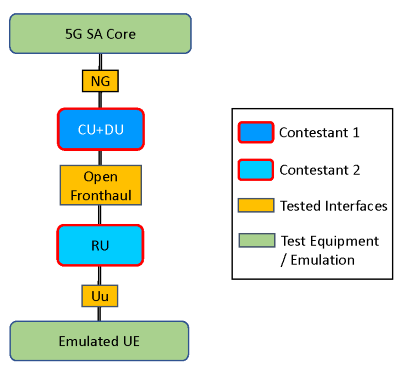2023 5G Challenge Update: Three Contestant Pairs Pass Stage Three End to End Interoperability Testing
By: Jeremy Glenn
At the National Telecommunications and Information Administration we’re working to catalyze the development of an open 5G wireless ecosystem to help the private sector move away from a highly consolidated marketplace with few vendors and technologies.
One way we’re doing this is through our lab at the Institute of Telecommunications Sciences, which is partnering with the Department of Defense on the 2023 5G Challenge. The 2023 5G Challenge tests whether an open 5G ecosystem can work in real world scenarios.
The challenge tests whether components of an open radio access network (Open RAN) can work together to ultimately create an end-to-end 5G network.
There are four stages of the challenge. As an update to our Stage Two recap, lab resources allowed 2023 5G Challenge judges to add JMA Wireless as a new contestant to the challenge in June. Since joining the challenge, JMA Wireless’ CU+DU subsystem completed and passed Stage Two wrap-around emulation testing.
We’re currently closing out stage three testing and stage four is underway. For the third round of testing, the challenge separates the contestant radio unit (RU) subsystems from the central unit and distributed unit pair (CU+DU) subsystems.
Stages Three and Four Testing Underway
 During Stage Three, a CU+DU contestant and an RU contestant work together to establish end-to-end (E2E) interoperability and work to ultimately create a 5G network. This requires collaboration and teamwork, to identify and fix areas where contestants have different interpretations or implementations of 3GPP standards and O RAN ALLIANCE specifications.
During Stage Three, a CU+DU contestant and an RU contestant work together to establish end-to-end (E2E) interoperability and work to ultimately create a 5G network. This requires collaboration and teamwork, to identify and fix areas where contestants have different interpretations or implementations of 3GPP standards and O RAN ALLIANCE specifications.
The 2023 5G Challenge relies on two main U.S. Open RAN test system vendors: Keysight and Viavi. During Stage Three, contestants use real equipment, like a cell phone, and simulated phone traffic, to test and evaluate system performance.
Six pairs of contestants were accepted for Stage Three. Three pairings successfully interoperated, meaning their components all worked together to successfully make a 5G phone call. Two contestants’ network components did not pass while one pair is still within their testing window.
The pairings that passed Stage Three are:
- Capgemini CU+DU and QCT/Benetel RU
- Mavenir CU+DU and NewEdge RU
- Radisys CU+DU and Lions RU
 During Stage Four, two pairs from Stage Three work together to demonstrate mobility. Mobility testing includes the handover of a UE from a source gNB to a target gNB, which is referred to as inter-gNB handover. Handover allows your phone call to switch from one tower to another, without dropping, as you drive down the highway.
During Stage Four, two pairs from Stage Three work together to demonstrate mobility. Mobility testing includes the handover of a UE from a source gNB to a target gNB, which is referred to as inter-gNB handover. Handover allows your phone call to switch from one tower to another, without dropping, as you drive down the highway.
Contestants will demonstrate mobility over two interfaces: (1) the NG interface, which connects two CUs through the 5G core, and (2) the Xn interface, which directly connects two CUs, bypassing the 5G core.
One group of contestants has begun mobility testing. A second mobility testing group may be scheduled, if time and resources permit. Lab testing closes September 15.
About 5G Challenge
The 5G Challenge is a research competition and collaboration between the U.S. Department of Defense (DoD) and NTIA’s Institute for Telecommunication Sciences (ITS) in Boulder, Colorado. The 2023 5G Challenge test plans and a description of the host lab environment are available on the 5G Challenge Resources page.
About the Institute for Telecommunication Sciences
ITS, the Nation’s Spectrum and Communications Lab, supports the Department of Defense FutureG & 5G Office through a combination of subject matter expertise in 5G and its research, development, test, and evaluation (RDT&E) laboratory in Boulder, including the Advanced Communications Test Site at the Table Mountain Field Site and Radio Quiet Zone.
